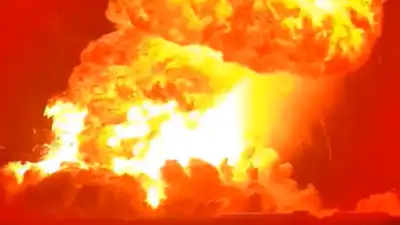The recent SpaceX Starship explosion has captured global attention and sparked intense discussion among space enthusiasts, engineers, and the general public. On June 18, 2025, a dramatic incident unfolded at SpaceX’s Starbase facility in Texas, where the upper stage of the Starship rocket—known as Ship 36—erupted into a massive fireball during preparations for a static fire test. This latest SpaceX Starship explosion highlights both the risks and rewards of pushing the boundaries of rocket science.
Eyewitnesses described a sudden, powerful blast that lit up the night sky and sent shockwaves through the surrounding area. The explosion occurred as teams were loading liquid oxygen and methane fuel into Ship 36, a routine but critical step before igniting the engines for a static fire test. Despite the violent nature of the event, SpaceX quickly confirmed that all personnel were safe and that established safety protocols had prevented any injuries. Local fire departments responded promptly to contain the resulting fires, which burned for over an hour before being extinguished.
The Impact of the SpaceX Starship Explosion
This incident is not the first time a Starship prototype has suffered a catastrophic failure. However, each explosion provides SpaceX engineers with valuable data to refine their designs and improve safety. The explosion at the Massey test site near Starbase caused significant damage to the test stand and surrounding infrastructure. The force of the blast was felt by nearby residents, many of whom reported hearing a loud boom and feeling vibrations through their homes.
SpaceX has built a reputation for rapid iteration and learning from failure. Elon Musk, the company’s founder, has repeatedly emphasized that setbacks are an expected part of developing revolutionary technology. “Success comes from what we learn,” Musk recently stated, reinforcing the idea that each test—whether it ends in triumph or disaster—brings humanity closer to the goal of interplanetary travel. The SpaceX Starship explosion is a reminder that the path to Mars is paved with both innovation and occasional mishaps.
Investigating the Cause and Looking Ahead
Following the SpaceX Starship explosion, teams worked through the night to secure the test site and begin the process of assessing the damage. The Federal Aviation Administration (FAA), which oversees commercial spaceflight in the United States, has not yet released a formal statement regarding the incident. However, prior to the explosion, airspace warnings indicated that SpaceX was targeting June 29 for the next full Starship test flight. It remains uncertain how this latest anomaly will affect the launch schedule.
SpaceX’s ability to recover quickly from setbacks is a hallmark of the company’s approach to space exploration. The Super Heavy booster intended for the upcoming test flight has already undergone successful static fire tests, demonstrating progress in other areas of the Starship program. The focus now shifts to analyzing the data from the explosion, identifying the root cause, and implementing corrective measures before moving forward with further tests.
Why the SpaceX Starship Explosion Matters
The SpaceX Starship explosion is more than just a headline-grabbing event—it is a critical moment in the ongoing effort to develop the world’s most powerful rocket. Starship is designed to be fully reusable, capable of carrying humans and cargo to the Moon, Mars, and beyond. Each test, whether successful or not, provides engineers with insights that drive the program forward. The stakes are high, but so are the potential rewards: a future where humanity is no longer confined to Earth.
Despite the challenges, SpaceX remains committed to its mission. The company’s willingness to test, fail, and learn sets it apart in the aerospace industry. The SpaceX Starship explosion is a testament to the bold vision that drives the company and the resilience required to turn that vision into reality.
The SpaceX Starship explosion on June 18, 2025, occurred during propellant loading at the Massey test site in Texas. The upper stage of the rocket, Ship 36, was destroyed in a massive fireball, but no injuries were reported thanks to strict safety protocols. This incident is the latest in a series of test anomalies that have provided valuable data for SpaceX engineers. The company’s rapid response and commitment to learning from failure ensure that progress continues toward the goal of interplanetary travel.
Stay Updated and Engaged
For the latest news on the SpaceX Starship explosion and upcoming test flights, follow official SpaceX announcements and trusted space news sources. Your curiosity and support help drive the future of space exploration.
